African-American Cultural Heritage Action Fund

The A.G. Gaston Motel in Birmingham was built as a place of luxury for minorities during the days of segregation, and stood at the center of several significant chapters of the Civil Rights movement. (City of Birmingham Archives)
We owe it to ourselves, our ancestors, and our future generations to preserve-and share-the full American story. Sometimes preserving that story means working through a difficult past to create a more inclusive future. Sometimes it means amplifying the voices of those who historically have been silenced. No matter the approach, we believe every American should be able to see themselves, their history, and their potential in both our collective story and our national landscape.
To encourage this growing movement, the National Trust and its partners are raising $25 million to create and invest in the African-American Cultural Heritage Action Fund-the largest preservation campaign ever undertaken on behalf of African-American history. Our mission: to draw attention to the remarkable stories that evoke centuries of African-American activism and achievement, and to tell our nation’s full history.
Indeed, the stories and places of African-American culture and heritage have always existed, but too often have not been fully acknowledged for the integral role they play in the fabric of American society. (more)
Video: This unsung friend of Jackie Robinson helped desegregate the NFL
Kenny Washington was a trailblazer who opened doors for other black players
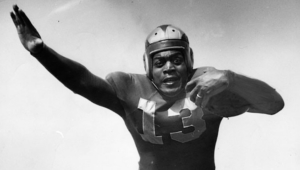
Kenny Washington at practice for the L.A. Rams in 1948. (Vic Stein/Los Angeles Public Library)
(Timeline.com) Kenny Washington had all the credentials to be a top NFL recruit: He’d led a major college team (UCLA) to a championship and had won the Douglas Fairbanks trophy for most outstanding player in college football. Time magazine wrote at the time that West Coast football fans considered him the most “brilliant player in the U.S.” But the year was 1940, and he had no offers from the NFL, since the organization had frozen out black players since 1933. Washington had to wait until 1947, but when he did get the chance, he helped pioneer a desegregated NFL. (video)
California’s Little-Known Genocide
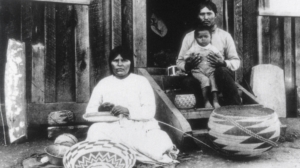
In 1850, around 400 Pomo people, including women and children, were slaughtered by the U.S. Cavalry and local volunteers at Clear Lake north of San Francisco. (NativeStock Pictures/UIG/REX/Shutterstock)
(History.com) “Gold! Gold from the American River!” Samuel Brannan walked up and down the streets of San Francisco, holding up a bottle of pure gold dust. His triumphant announcement, and the discovery of gold at nearby Sutter’s Mill in 1848, ushered in a new era for California-one in which millions of settlers rushed to the little-known frontier in a wild race for riches.
But though gold spelled prosperity and power for the white settlers who arrived in California in 1849 and after, it meant disaster for the state’s peaceful indigenous population.
In just 20 years, 80 percent of California’s Native Americans were wiped out. And though some died because of the seizure of their land or diseases caught from new settlers, between 9,000 and 16,000 were murdered in cold blood-the victims of a policy of genocide sponsored by the state of California and gleefully assisted by its newest citizens.
Today, California’s genocide is one of the most heinous chapters in the state’s troubled racial history, which also includes forced sterilizations of people of Mexican descent and discrimination and internment of up to 120,000 people of Japanese descent during World War II. But before any of that, one of the new state’s first priorities was to rid itself of its sizeable Native American population, and it did so with a vengeance. (more)
A Look at WWII and Civil Rights through the Life of a Veteran
Just East of Waco, in the town of Riesel you might meet Prez.
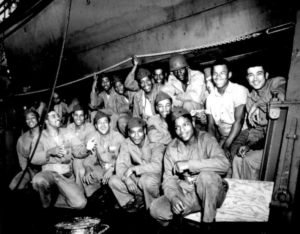
A group of African American Marines on a Coast Guard Transport in the Pacific. (National Archives)
Prez: I used to go to the VFW over there and a guy over there said what’s your name. I said Olen Hamilton. He said Olen Hamilton. I said yeah like the President. From that day on that’s what I’m known as.
Prez was born in 1919 during a time when everything was segregated, from restrooms, to water fountains. There were even cities African Americans weren’t allowed to be in after dark.
Prez: I understand in my little town Riesel you couldn’t be caught there after sundown. If you did something bad might happen to you.
Speaking with Baylor History Professor James SoRell, He says these types of communities were common in the state.
SoRell: There was throughout Texas signs posted on the edge of town “Don’t let the sun go down on you in…” preceded by the N Word.
In 1941 Prez knew some of the things that were happening on the world stage but not everything.
Prez: We didn’t have radio but we took the paper. It was big news, Japanese Bomb Pearl Harbor…Pearl Harbor. Where is that? We wasn’t talking about pearl Harbor in school, we didn’t go that far. Hadn’t heard anything about Pearl Harbor. Just before that I knew Hitler had come to power. (more)
TIPHC Bookshelf
Published scholarship on black history in Texas is growing and we’d like to share with you some suggested readings, both current and past, from some of the preeminent history scholars in Texas and beyond. We invite you to take a look at our bookshelf page – including a featured selection – and check back as the list grows. A different selection will be featured each week. We welcome suggestions and reviews. This week, we offer, “The Brackenridge Colored School: A Legacy of Empowerment through Agency and Cultural Capital inside an African American Community,” by Jerelyne Castleberry Williams.
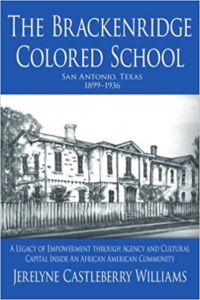 The evolving narrative within the pages of the book uncovers the deeply rutted paths to literacy ownership carved by turn-of-the-twentieth century African American citizens’ groups in San Antonio, Texas. The story becomes more than a turn-of-the-twentieth century Colored school’s history; it becomes a people’s story inculcating the essence of their cultural history in San Antonio’s cultural landscape. Through self-determinist strategies powered by agency and cultural capital, these literacy warriors step forward to stake their claim for literacy ownership.
The evolving narrative within the pages of the book uncovers the deeply rutted paths to literacy ownership carved by turn-of-the-twentieth century African American citizens’ groups in San Antonio, Texas. The story becomes more than a turn-of-the-twentieth century Colored school’s history; it becomes a people’s story inculcating the essence of their cultural history in San Antonio’s cultural landscape. Through self-determinist strategies powered by agency and cultural capital, these literacy warriors step forward to stake their claim for literacy ownership.
The impetus for the establishment of the George W. Brackenridge Colored School is initiated by a small group of Colored people who come to petition for more schools for their children. Within the story of the citizens’ groups and the Brackenridge Colored School, another person emerges as a symbol of the school’s beginnings. The school’s namesake, George W. Brackenridge, moves in and out of the events centered on the Board’s decisions regarding learning facilities for the Colored community.
For all of his philanthropic endeavors during the nineteenth and twentieth centuries, George W. Brackenridge remains as a memorialized symbol still standing tall, not only in the African American communities, but in other communities and institutions throughout San Antonio and the state of Texas. However, only a few remember, or are even aware of the Colored citizens’ initiatives put forth for the building of the school, bearing the name of its financial and morally bent benefactor, a much needed ally in the nearby Colored community surrounding the school at the turn of the twentieth century.
This Week in Texas Black History, Dec. 3-9
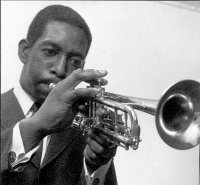
Kenny Dorham
Dec5
On this day in 1972, Austin musician Kenny Dorham died of kidney failure at age 48 in New York City. Dorham was one of the great trumpet pioneers of the bebop era, and worked with many of the bebop giants in the ’40s and ’50s, including Dizzy Gillespie, Billy Eckstine, Lionel Hampton, and Thelonious Monk.
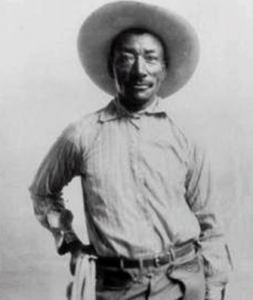
Willie M. Pickett
Dec5
Willie M. “Bill” Pickett, the cowboy known as the “Dusky Demon” and inventor of the rodeo sport of bulldogging (steer wrestling), was born on this day in 1870 in Taylor, northeast of Austin. In 1971, Pickett was the first black man elected to the National Cowboy Hall of Fame and Western Heritage Center in Oklahoma. In 1993, the U.S. Postal Service honored him as part of its Legends of the West series of stamps.
Dec6
The 13th Amendment, abolishing slavery, was ratified by three-fourths of the states on this day in 1865, officially becoming part of the U.S. Constitution. The amendment declared that “neither slavery nor involuntary servitude, except as a punishment for crime whereof the party shall have been duly convicted, shall exist within the United States, or any place subject to their jurisdiction.” However, when the newly elected 11th Texas Legislature met in August 1866, the members refused to ratify either the 13th or 14th Amendment (granting citizenship to African Americans). The legislature wanted to return Texas as much as possible to the way it was before the war and restrict the rights of African Americans. Texas would not ratify the 13th amendment until February 18, 1870. Mississippi would be the last state to comply, ratifying the amendment in 1995, but the state didn’t officially notify the U.S. Archivist until 2012, when the ratification finally became official.
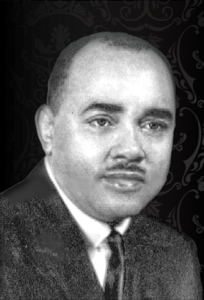
Julius Carter
Dec7
Publisher Julius Carter was born this day in 1914 in Houston. Carter founded the Forward Times newspaper in 1960 when segregation was in full force in Houston. Carter realized his vision of the Forward Times becoming a voice for the city’s African-American community.

Comer Cottrell, Jr.
Dec7
Philanthropist and founder of Pro-Line Corporation, maker of black hair products, Comer Cottrell, Jr., was born on this day in 1931 in Mobile, Alabama. Cottrell founded Pro-Line in Los Angeles in 1970, but relocated the business to Dallas in 1980. Pro-Line became the largest black-owned firm in the Southwest and one of the most profitable black companies in the United States. He is noted for popularizing the “Jheri curl” hairstyle. Cottrell became part owner of Texas Rangers baseball team in 1989, becoming the first African-American to hold such a stake in a Major League Baseball team and was also the first black member of the powerful Dallas Citizens Council.
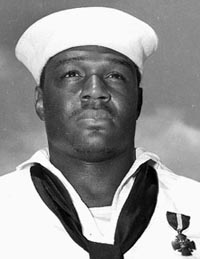
Doris Miller
Dec7
On this day in 1941, Navy messman Doris Miller, a Waco native was aboard the USS West Virginia when the Japanese attacked Pearl Harbor. Miller moved several wounded sailors to safety and then manned an anti-aircraft gun, for which he had no training (because the Navy limited black sailors to non-combat roles and menial duties), and fired at attacking planes. For his actions, Miller was the first African-American to be awarded the Navy’s second highest honor, the Navy Cross.

Willie M. Pickett
Dec9
Taylor native Bill Pickett became the first African-American elected to the Rodeo Cowboy Hall of Fame on this day in 1971. Pickett is noted as the originator of “steer wresting” with his technique of “bulldogging” steers, during which Pickett would subdue unruly cows by jumping from his horse to the cow, wrestling him to the ground, then biting the creature’s lip. Pickett said he got the idea from watching dogs do the same thing when they were herding cows. Known as the “Dusky Demon,” Pickett has also been honored by the U.S. Postal Service as part of its “Legends of the West” series of commemorative stamps.
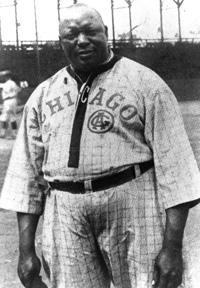
Rube Foster
Dec9
On this day in 1930, Calvert native Rube Foster, founder of baseball’s first successful all-black league, the Negro National League, died in Kankakee, Illinois. Known as the “Father of Black Baseball,” Foster was a star pitcher and manager for the Chicago American Giants, as well as league commissioner. The NNL, headquartered in Kansas City, Mo., had teams in the South and Midwest including Texas teams such as the Austin Black Senators, Fort Worth Black Panthers, and the Houston Eagles. Foster was elected to the Baseball Hall of Fame in 1981.
Blog: Ron Goodwin, Ph.D., author, PVAMU history professor
Ron Goodwin’s bi-weekly blog appears exclusively for TIPHC. Goodwin is a San Antonio native and Air Force veteran. Generally, his column addresses contemporary issues in the black community and how they relate to black history. He and the TIPHC staff welcome your comments.
Latest Entries
A New Hope
Forgive me for borrowing the title of one of the most profitable films in history, “Star Wars: A New Hope.” I’ve always been enamored by space. I’m a child of the 1960s and I remember playing with my Major Matt Mason action figure (not a doll!) as my family [...]
Tell me the truth
Democracy – a) government by the people, b) a government in which the supreme power is vested in the people and exercised by them, directly or indirectly through a system of representation usually involving periodically held free elections. Merriam-Webster Dictionary There were many things I learned from my father. [...]
Submissions Wanted
Historians, scholars, students, lend us your…writings. Help us produce the most comprehensive documentation ever undertaken for the African American experience in Texas. We encourage you to contribute items about people, places, events, issues, politics/legislation, sports, entertainment, religion, etc., as general entries or essays. Our documentation is wide-ranging and diverse, and you may research and write about the subject of your interest or, to start, please consult our list of suggested biographical entries and see submission guidelines. However, all topics must be approved by TIPHC editors before beginning your research/writing.
We welcome your questions or comments. Please contact Mr. Michael Hurd, Director of TIPHC, at mdhurd@pvamu.edu.
